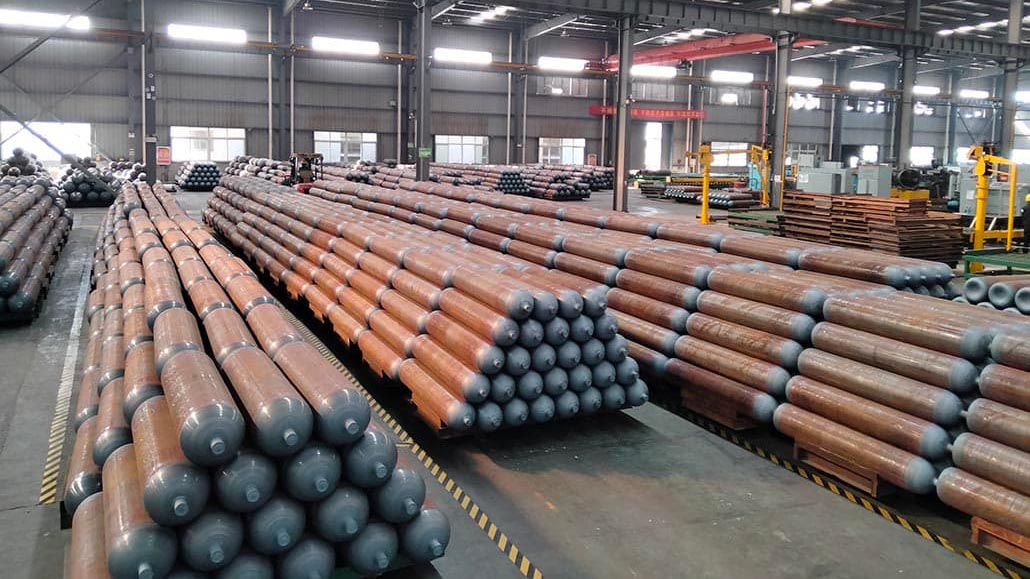Industrial gas cylinders are containers used for storing and transporting compressed gases used in various applications. These cylinders safely hold high-pressure and are made of durable materials such as steel or aluminum. Industrial gas cylinders come in different sizes and shapes, but they typically have a cylindrical body with a valve and a pressure on top.
The valve controls the release of the gas when needed, while the pressure gauge indicates the pressure level inside the cylinder. These cylinders are commonly used for storing gases such as oxygen, nitrogen, hydrogen, helium, carbon dioxide, and acetylene. The gases stored in industrial gas cylinders find wide application in industries such as manufacturing, construction, healthcare, welding and metal fabrication, chemical processing, and food and beverage.
| Implementation standard |
Cylinder Model
and Standard |
Norminal Working Pressure
(bar) |
Hyd.test Pressure
(bar) |
Design Wall Thickness
(mm) |
Material |
Bottom Shape |
Outer Diameter
(mm) |
Water Capacity
(L) |
Length
(mm) |
Weight
(kg) |
| EN ISO9809-1 |
267-V-150bar |
150 |
250 |
6.0 |
37Mn |
Concave |
267 |
35 |
810 |
39.9 |
| 40 |
910 |
44.2 |
| 45 |
1010 |
48.5 |
| 50 |
1110 |
52.8 |
| 55 |
1210 |
57.1 |
| 60 |
1310 |
61.4 |
| 65 |
1410 |
65.7 |
| 68 |
1470 |
68.3 |
| 232-V-200bar |
200 |
300 |
5.5 |
34CrMo4 |
Concave |
232 |
30 |
895 |
34.6 |
| 35 |
1030 |
39.2 |
| 40 |
1165 |
43.8 |
| 45 |
1300 |
48.4 |
| 50 |
1435 |
53.0 |
| 60 |
1705 |
62.2 |
| 232-V-230bar |
230 |
345 |
5.7 |
34CrMo4 |
Concave |
232 |
30 |
895 |
34.6 |
| 35 |
1030 |
39.2 |
| 40 |
1165 |
43.8 |
| 45 |
1300 |
48.4 |
| 50 |
1435 |
53.0 |
| 60 |
1705 |
62.2 |
| 356-V-250bar |
250 |
375 |
9.6 |
34CrMo4 |
/ |
356 |
76 |
1068 |
96.5 |
| 150 |
1910 |
173.0 |
| 160 |
2024 |
183.4 |
| 165 |
2028 |
188.5 |
| 406-V-250bar |
250 |
375 |
10.9 |
34CrMo4 |
/ |
406 |
115 |
1218 |
148.6 |
| 200 |
1960 |
236 |
The industrial gas cylinder market is primarily distributed in regions like North America, Europe, Asia Pacific, and the Middle East, with Asia Pacific being one of the fastest-growing regions. As various sectors continue to develop and innovate, the industrial gas cylinder market also undergoes constant change and development. In the future, we will witness several trends. Firstly, there will be innovations and upgrades in cylinder materials, such as the widespread application of composite material cylinders, which will enhance performance and quality.

Secondly, there will be innovations and improvements in cylinder filling technologies, such as the application of automated filling techniques, which will improve production efficiency and safety. Additionally, there will be a growing emphasis on cylinder recycling and reuse to reduce resource wastage and environmental pollution.
| Implementation standard |
Cylinder Model
and Standard |
Norminal Working Pressure |
Hyd.test Pressure |
Design Wall Thickness
(mm) |
Material |
Bottom Shape |
Outer Diameter
(mm) |
Water Capacity
(L) |
Length
(mm) |
Weight
(kg) |
| DOT-3AA |
279-V-2495 psig |
172 bar
(2495 psig) |
287 bar
(4163 psig) |
7.1 |
30CrMo
(4130X) |
Concave |
279 |
60 |
1263 |
77.9 |
| 65 |
1355 |
83.1 |
| 70 |
1448 |
88.2 |
| 75 |
1540 |
93.4 |
| 80 |
1633 |
98.5 |
| 82 |
1670 |
100.6 |
| 85 |
1726 |
103.7 |
| 90 |
1818 |
108.8 |
| 95 |
1911 |
114.0 |
| 100 |
2003 |
119.1 |
| 105 |
2096 |
124.3 |
Overall, the industrial gas cylinder market, as a vast market, will experience higher growth and broader application prospects driven by continuous development and innovation in industries worldwide. We have reason to believe that with the advancement in industrial sectors worldwide






 Language :
Language : English
English français
français español
español






 IPv6 network supported
IPv6 network supported
